Lesson 31
Where’s Sally?
Where is Sally?
Vocabulary
-
garden [‘gɑ:dn] n. garden
-
under [‘ʌndə] prep. under
-
tree [tri:] n. tree
-
climb [klaim] v. to climb
-
who [hu:] pron. who
-
run [rʌn] v. to run
-
grass [grɑ:s] n. grass, lawn
-
after [‘ɑ:ftə] prep. after
-
cat [kæt] n. cat
Text and Translation
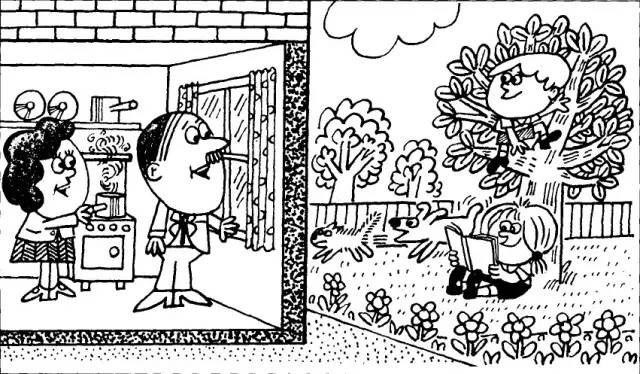
Where’s Sally, Jack?
Jack, where is Sally?
She’s in the garden, Jean.
She is in the garden, Jean.
What’s she doing?
What is she doing?
She’s sitting under the tree.
She is sitting under the tree.
Is Tim in the garden, too?
Is Tim also in the garden?
Yes, he is.
Yes, he is.
He’s climbing the tree.
He is climbing the tree.
I beg your pardon?
Excuse me?
Who’s climbing the tree?
Who is climbing the tree?
Tim is.
Tim is.
What about the dog?
What about the dog?
The dog’s in the garden, too.
The dog is also in the garden.
It’s running across the grass.
It is running across the grass.
It’s running after a cat.
It is running after a cat.
Lesson Focus:
Present Continuous Tense

After nearly three months of study, we are now entering the first tense. Step by step is the foundation of learning. Keep it up, kids!
1To express actions or events that are happening at the moment in English, use the present continuous tense form of the verb.
The present continuous tense consists of the present tense form of be (am, is, are) + present participle.
For example, in the text, She’s sitting under the tree and He’s climbing the tree are both in the present continuous tense.
For most verbs, simply add -ing to the verb to form the present participle, such as doing, climbing.
For verbs ending in -e, drop the -e and add -ing, such as making.
If a verb has only one vowel followed by a consonant, double the consonant before adding -ing, such as running, sitting.
2Interrogative: To change a sentence in the present continuous tense into a general question, simply move the auxiliary verb to the front. For example:
He’s reading a book.
Is he reading a book?
Is he reading a book?
3Negative: The negative form of the present continuous tense places the word ‘not’ after the auxiliary verb. For example:
The dog is drinking its water.
The dog is not drinking its water.
The dog is not drinking its water.
Vocabulary for this lesson
 1climb v.
1climb v.
1
To climb:
The children are always climbing trees.
The children are always climbing trees.
He likes climbing mountains.
He likes climbing mountains.
2
To rise gradually (increase):
The temperature is climbing steadily.
The temperature is rising steadily.
3
To rise in social status, etc.:
He has climbed to a very high position in his field.
He has reached a very high position in his field.
2run v.
1
To run:
He is running quickly.
He is running quickly.
2
To flow; to pour out:
The current is running strong.
The water is flowing rapidly.
3
To chase; to pursue:
The dog is running after a cat.
The dog is chasing a cat.
Many young men are running after that girl.
Many young men are pursuing that girl.
Lesson 32
What’s he / she / it doing?
What is he / she / it doing?
Vocabulary
1 type [taip] v. to type
2 letter [‘letə] n. letter
3 basket [‘bɑ:skit] n. basket
4 eat [i:t] v. to eat
5 bone [bəun] n. bone
6 clean [kli:n] v. to clean
7 tooth [tu:θ] n. tooth
8 cook [kuk] v. to cook
9 milk [milk] n. milk
10 meal [mi:l] n. meal
11 drink [driŋk] v. to drink
12 tap [tæp] n. (water) tap
Text and Translation
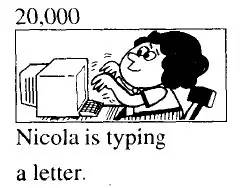
Number 20,000.
T:Is Nicola making the bed?
Is Nicola making the bed?
S:No, she isn’t making the bed.
No, she is not making the bed.
T:What’s she doing?
What is she doing?
S:She’s typing a letter.
She is typing a letter.

Number 90,000.
T:Is Jack putting on his shirt?
Is Jack putting on his shirt?
S:No, he isn’t putting on his shirt.
No, he is not putting on his shirt.
T:What’s he doing?
What is he doing?
S:He’s reading a magazine.
He is reading a magazine.
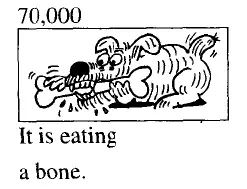
Number 70,000.
T:Is the dog drinking its milk?
Is the dog drinking its milk?
S:No, it isn’t drinking its milk.
No, it is not drinking its milk.
T:What’s it doing?
What is it doing?
S:It’s eating a bone.
It is eating a bone.
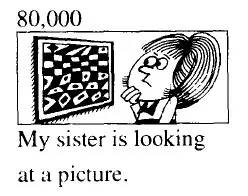
Number 80,000.
T:Is your sister emptying the basket?
Is your sister emptying the basket?
S:No, she isn’t emptying the basket.
No, she is not emptying the basket.
T:What’s she doing?
What is she doing?
S:She’s looking at a picture.
She is looking at a picture.
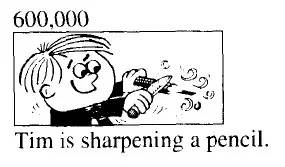
Number 600,000.
T:Is Tim cleaning his teeth?
Is Tim cleaning his teeth?
S:No, he isn’t cleaning his teeth.
No, he is not cleaning his teeth.
T:What’s he doing?
What is he doing?
S:He’s sharpening a pencil.
He is sharpening a pencil.
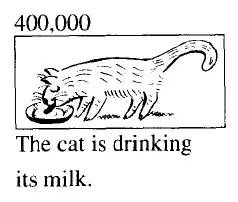
Number 400,000.
T:Is the cat eating?
Is the cat eating?
S:No, it isn’t eating.
No, it is not eating.
T:What’s it doing?
What is it doing?
S:It’s drinking its milk.
It is drinking its milk.
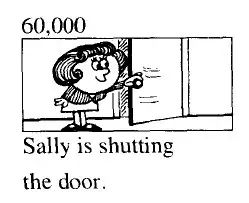
Number 60,000.
T:Is Sally dusting the dressing table?
Is Sally dusting the dressing table?
S:No, she isn’t dusting the dressing table.
No, she is not dusting the dressing table.
T:What’s she doing?
What is she doing?
S:She’s shutting the door.
She is shutting the door.
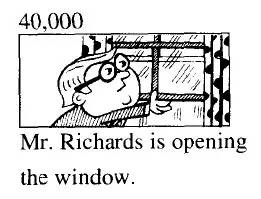
Number 40,000.
T:Is Mr. Richards turning on the light?
Is Mr. Richards turning on the light?
S:No, he isn’t turning on the light.
No, he is not turning on the light.
T:What’s he doing?
What is he doing?
S:He’s opening the window.
He is opening the window.
Lesson Focus:
Rules for changing verbs to present participle
(Present Continuous Tense)

1In general, add -ing to the verb to form:
work→working
sleep→sleeping
wait→waiting
study→studying
read→reading
talk→talking
2For verbs ending in a silent -e, drop the -e and add -ing:
smile→smiling
move→moving
write→writing
However, if the verb ends in a pronounced -e, do not drop the -e:
see→seeing
agree→agreeing
3For verbs ending in a stressed closed syllable or r-syllable with only one consonant letter, double the final consonant and add -ing:
sit→sitting
plan→planning
prefer→preferring
4For verbs ending in -ie, usually change -ie to -y and then add -ing:
die→dying
lie→lying
Note:
1. For verbs ending in the letter l, if the last syllable is a stressed syllable, the final consonant must be doubled before adding -ing.
For example, control / controlling,
but if the last syllable is unstressed, you can double the l (British English) or not double the l (American English)
For example, travel / travel(l)ing.
2. The rules for changing nouns to plural, adjectives and adverbs to comparative and superlative, and verbs to past tense and past participle also have the “change y rule,” which states “change y to i and then…” but the present participle of verbs does not follow the “change y rule.”